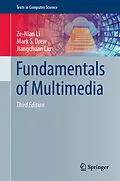Topics and features:
- Presents a brief history and overview of the key concepts in multimedia, including important data representations and color science
- Discusses the impact of social media and cloud computing on information sharing, as well as on multimedia content search and retrieval
- Includes numerous helpful study exercises at the end of each chapter
- Reviews lossless and lossy compression methods for image, video and audio data
- Examines the demands placed by multimedia communications on wired and wireless networks
- Provides supplementary resources for both students and instructors at an associated website
This classroom-tested textbook is ideal for upper-level undergraduate and graduate courses on multimedia systems. Practitioners in industry interested in current multimedia technologies will also find the book to be a useful reference.
Drs. Ze-Nian Li, MarkS. Drew, and Jiangchuan Liu are Professors in the School of Computing Science at Simon Fraser University, Vancouver, BC, Canada.Autorentext
Drs. Ze-Nian Li, Mark S. Drew, and Jiangchuan Liu are Professors in the School of Computing Science at Simon Fraser University, Vancouver, BC, Canada.
Klappentext
PREVIOUS EDITION
Inhalt
Part I: Introduction and Multimedia Data Representations.- Introduction to Multimedia.- A Taste of Multimedia.- Graphics and Image Data Representations.- Color in Image and Video.- Fundamental Concepts in Video.- Basics of Digital Audio.- Part II: Multimedia Data Compression.- Lossless Compression Algorithms.- Lossy Compression Algorithms.- Image Compression Standards.- Basic Video Compression Techniques.- MPEG Video Coding: MPEG-1, 2, 4 and 7.- Modern Video Coding Standards: H.264, H.265, and H.266.- Basic Audio Compression Techniques.- MPEG Audio Compression.- Part III: Multimedia Communications and Networking.- Network Services and Protocols for Multimedia Communications.- Internet Multimedia Content Distribution.- Multimedia over Wireless and Mobile Networks.- Cloud Computing for Multimedia Services.- Part IV: Human-Centric Interactive Multimedia.- Online Social Media Sharing.- Augmented Reality and Virtual Reality.- Content-Based Retrieval in Digital Libraries.- Cloud Computing for Multimedia Services.
